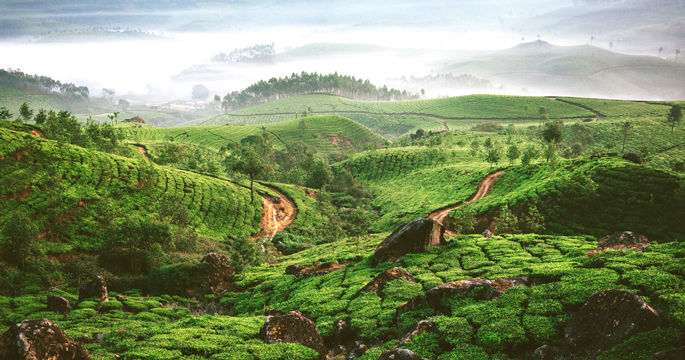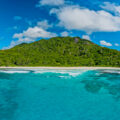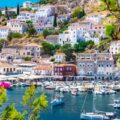Go beyond the usual to reap the rewards of these less expected destinations
The problem with vacation hotspots is just that. The things that put these destinations at the top of the list mean everyone wants to go there. This can be translated to overbooked flights, peak season pricing, and cafes with long waits for tables. But what if you could get all the best parts of these “A-list” destinations without the crowds — and discover somewhere new and exciting? To help you get packing, here are ten destinations that are trending but still flying under the mainstream travel radar.
Trinidad, Cuba
For decades, Cuba was the Caribbean’s forbidden fruit for US travelers. Those days are over, and the Pearl of the Antilles will welcome more than 3 million tourists in 2024. Havana remains the number one destination and a must-do for the classic cars, Hemingway haunts, and nightclubs. Modern beach resorts along the north coast also garner their share of the holiday crowd with the enticements of white sands and all-inclusive indulgences.
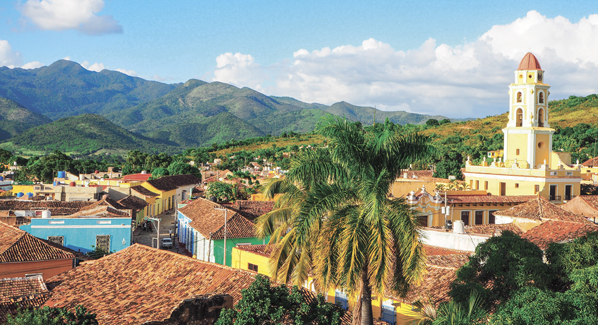
The streets and rooftops of Trinidad, Cuba. Photo: Aurore Kervoern/iStock
Recently, a limited number of savvy travelers have set their sights on a region some 180 miles east of the capital city. Trinidad is known as Cuba’s Colonial Jewel. It is a town of narrow cobblestone streets, vintage terracotta-roofed homes, and colonial-era mansions between the mountains and the Caribbean Sea. Once a thriving center of the nation’s sugar trade, Trinidad’s decline into a regional backwater by the early 1900s protected the town’s historic architecture from redevelopment.
Today, Trinidad is recognized as a UNESCO World Heritage Site that provides a glimpse into Cuba’s past and an authentic slice of traditional village life. Centuries-old homes are now restored as casa particulares —Cuba’s version of a bed & breakfast — and many of the grand residences surrounding the iconic Plaza Mayor are transformed into museums.
History and culture aren’t the only draws in Trinidad. The town has a thriving cultural scene and a salsa-infused nightlife. Beach lovers are just a short taxi ride away from clear Caribbean waters and the sands of Playa Ancon and Playa La Boca. Trinidad is also the gateway to the Topes de Collantes National Park, a mountainous region known for hiking trails, waterfalls, and bird life.
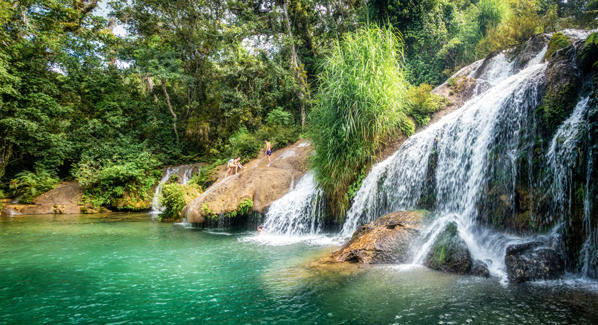
Gran Parque Natural Topes de Collantes showcases the waterfalls of El Nicho, Cuba. Photo: Eloi Omella/iStock
Sri Lanka
Herb and spice-laden cuisines, classic temples, dazzling beaches, lush tropical forests, hillsides terraced in emerald green tea plantations, and rice paddies are postcard images. These are the lures of Southeast Asia, and millions answer the call. More than 9 million made their way to Vietnam in 2023, 10 million opted for Indonesia, and a whopping 32 million visited Thailand. In contrast, Sri Lanka’s nearly 1 million foreign visitors pale in comparison, but that’s good for those wanting to beat the crowds to an island nation that is projected to be one of the fastest-growing tourism destinations in 2024.
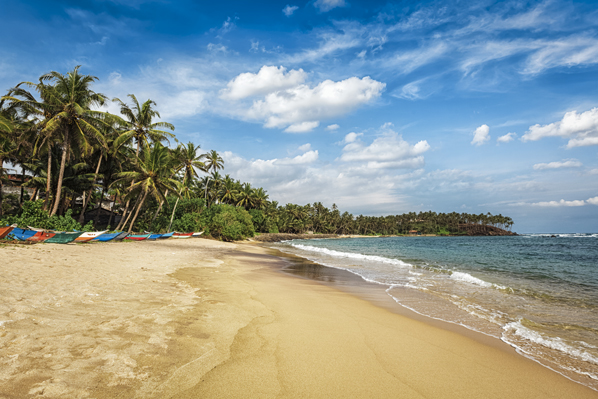
One of Sri Lanka’s more popular spots is the beach at Mirissa. Photo: Dmitry Rukhlenko/iStock
Everyone from surfers, scuba divers, history buffs, and foodies will find Sri Lanka rewarding. Traditional fishing villages on the island’s southern shores now share space with a growing collection of world-class resorts. Rainforest-clad peaks in the interior highlands offer hiking, rafting, and the best wildlife safaris outside of Africa. Stunningly beautiful landscapes are dotted by the remains of ancient cities and historic temples, including 8 UNESCO World Heritage Sites.
Safety is another factor contributing to Sri Lanka’s rise in the tourism ranks. Once known for its decades-long civil conflicts, Sri Lanka has recently transitioned to a more welcoming and stable governance. The US State Department’s travel risk assessment now puts Sri Lanka on par with European destinations such as France, Germany, and Italy. And for many, the real clincher for Sri Lanka is the value. Spend $100 daily to score a three-star hotel and memorable restaurant fare. Double that; you could live large at an upscale waterfront resort.
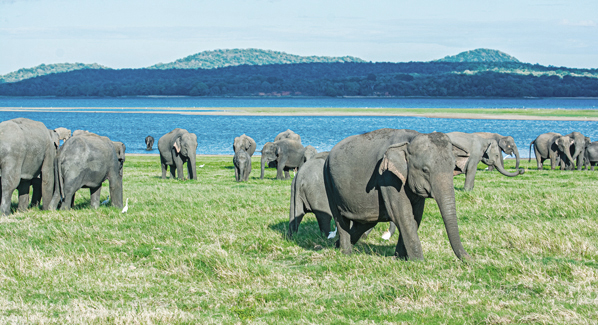
Elephants At Minneriya National Park in Sri Lanka. Photo: SamanWeeratunga/iStock
North Bali, Indonesia
Bali is ranked among the world’s most desirable honeymoon destinations. It’s also a longtime favorite with surfers, backpackers, and wellness travelers. The Nusa Dua enclave draws an impressive collection of A-listers, and the island has recently evolved into a mecca for digital nomads. This broad-based appeal means things can get crowded at the popular beach towns scattered along the southern shore.
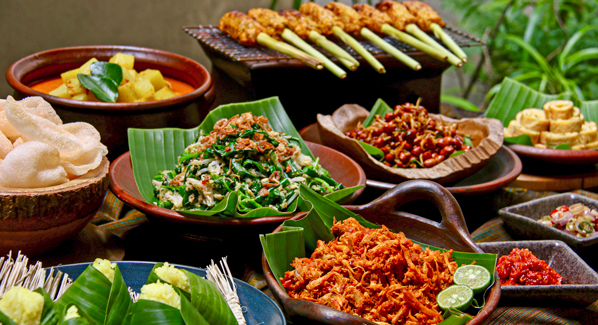
Nasi Campur Bali is a Popular Balinese rice dish with various side dishes. Photo: MielPhotos2008/iStock
For a more relaxed take on Bali, in-the-know vacationers head north. Long isolated from southern cities by a mountainous interior, the island’s northern coast remains a realm of terraced rice fields, lush forests, tidy villages, and classical temples. Bali is known as the island of 1,000 temples, and some of the most intriguing and scenic shrines can be found in the north. In contrast to the golden-granular beaches of the south, several of north Bali’s most popular shores are covered in fine black volcanic sands. Snorkelers find clear waters close to shore, scuba divers meet up with dolphins, and sun worshipers can relax beachside at thatch-roofed local eateries and barefoot-casual guest houses.
The north shore has several attractive mid- to upper-range resorts in the Lovina Beach area. More options await in the foothills, where the emphasis moves from water to wellness at properties that offer relaxing mixtures of international and traditional Balinese therapies. Foodies can explore a world of flavors that draws from Maylay, Chinese, and Indian cuisines and use a redolent array of fresh herbs and spices. To be noticed are authentic presentations of Nasi Goreng, savory sambals, and ginger-laden soto soups laced with cardamom, clove, and ginger.
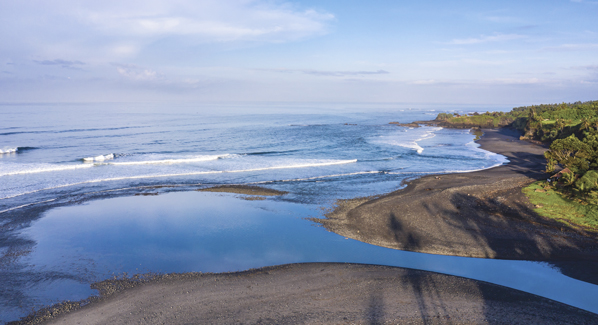
Black sand beach located in West Bali in Indonesia. Photo: joakimbkk/iStock
Cali, Colombia
No longer seen as the realm of drug lords and guerrilla insurrectionists, Colombia has recently emerged as South America’s fastest-growing tourism destination. The numbers are still a relatively modest 3 million foreign visitors per year, but the trend remains upward for a country that offers diverse travel-worthy experiences and environs.
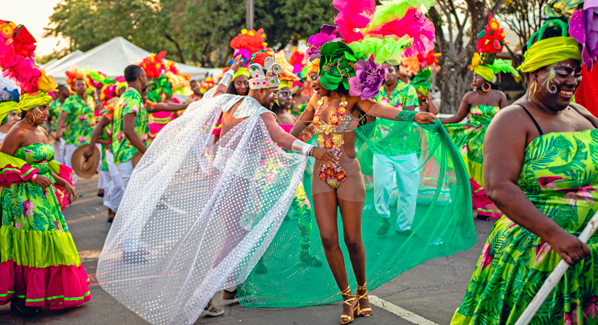
Street dancers during the December annual carnival in Cali, Colombia. Photo: Wirestock/iStock
At about the size of Texas and California combined, Colombia offers an enticing range of landscapes from Caribbean coasts and Pacific surf to jungles, highland plateaus, and the towering peaks of the Andes. The cultural scene is equally diverse, as there are upscale cityscapes with world-class shopping, dining, and nightlife, historic sites dating from the colonial times, and bucolic villages reminiscent of an earlier era. While Bogota, Cartagena, and Barranquilla are the favorite starting points for exploration, Santiago de Cali is another city trending.
Cali is best known for dancing and is often billed as the world capital of salsa. It’s reported that the city has more than 7,000 professional salsa dancers and instructors supporting a thriving network of studios and dance schools. Those who would rather watch than dance are also accommodated by a year-long calendar of festivals, street art, and performances that culminate in December’s Feria de Cali. This week-long observance is a homecoming for the community and a city-wide extravaganza packed with everything from dance marathons and costumed processions to concerts, food festivals, and street parties.
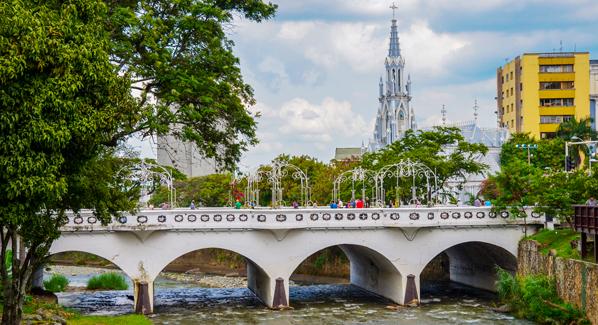
Urban landscapes and architecture in Cali, Colombia. Photo: Emmanuel Flores/iStock
Da Nang, Vietnam
Vietnam’s most trending vacation destination has only recently drawn the attention of North American travelers. But don’t expect bucolic beach life on arrival, as Da Nang is well-known in regional circles, attracting more than 4 million visitors from surrounding Asian nations in 2023. The draw for Da Nang isn’t the cultural and historic charms of Hanoi, Hue, and Ho Chi Min City. Instead, this once-sleepy port town has transformed into a burgeoning resort destination offering ultra-modern hotels, fine dining, nightlife, shopping, and active sports.
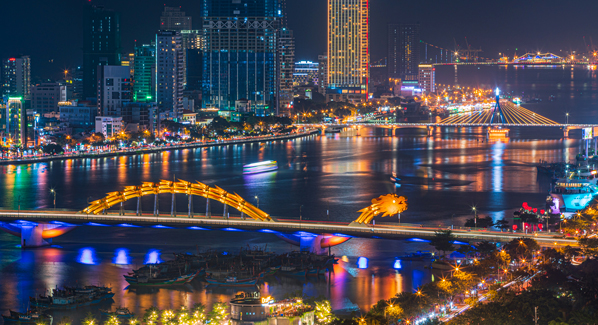
Dragon Bridge in Da Nang City, central Vietnam. Photo: Pham Hung/iStock
The centerpiece of Da Nang’s waterfront is My Khe Beach. Apt comparisons would be Rio De Janeiro’s Copacabana or Miami’s South Beach, as these famous strands lie in the heart of lively urban districts known for nightlife, dining, and people-watching. The amber sands of nearby Non Nuoc have earned it a reputation as one of the world’s most beautiful beaches. Other favorites include Bac My An Beach, known for 5-star beach resorts, and the Son Tra Peninsula, which offers quiet, calm coves away from the crowds.
Sun and sand are not Da Nang’s only attractions. The city has gained a reputation as a regional culinary hotspot, and food tours are becoming a thing. Skirting the banks of the Han River, Bach Dang is the epicenter of the city’s dining and nightlife scenes, and after dark, it becomes one of Southeast Asia’s most dynamic walking streets. Da Nang is a city of festivals, concerts, and celebrations. Highlights include the Asian Film Festival, the Ba Na WOW summer festival series, the Danang Electronic Carnival, and the International Fireworks Festival, which draws hundreds of thousands with spectacular pyrotechnic displays.
The Marble Mountains rise just a few miles from the city center, which delight outdoor enthusiasts with trails, caves, and stairways leading to scenic peaks. Another nearby can’t-miss destination is the Golden Bridge. This 500-foot walkway, which spans a cloud- shrouded mountaintop gorge, appears to be cradled by two gigantic hands.
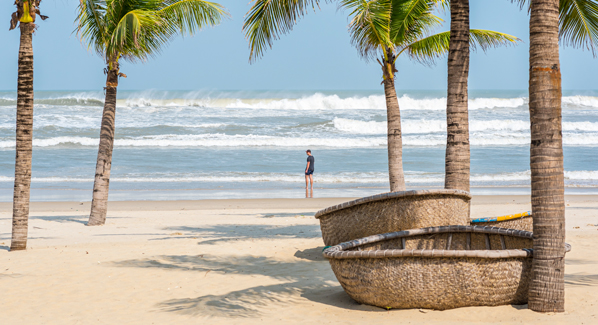
My Khe beach in Da Nang, Vietnam. Photo: David_Bokuchava/iStock
Eleuthera, Bahamas
The Bahamian Island of Eleuthera is best known for its charming colonial cottages, golf cart-navigated lanes, and iconic pink sand beaches of Harbour Island. This increasingly upscale enclave, located just offshore of the main island’s northeast corner, delivers a postcard-perfect vacation experience that attracts celebrities and one-percenters in search of quiet anonymity.
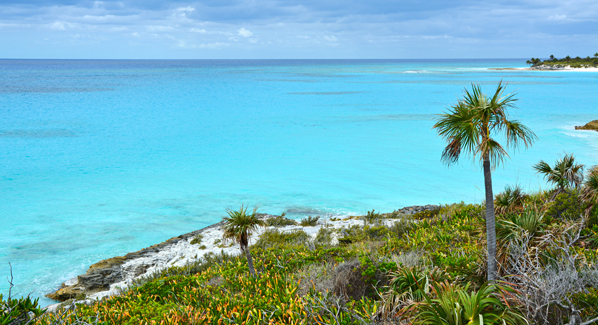
Scenic sea view from the coast of Eleuthera island. Photo: StudioBarcelona/iStock
But there’s a lot more to Eleuthera. It is a thin, sickle-shaped island that stretches some 100 miles to the south, offering miles of deserted beaches flanked by blue Atlantic waters to the east and the calm shores of the island’s namesake sound to the west. And yes, there is plenty of pink sand along the way.
At the midpoint of the island sits Governor’s Harbour. Here, the vintage cottages could be tidier, and the waterfront is more often populated by local fishermen enjoying a cold Kalik beer after cleaning their catch. The scene is decidedly Out Island authentic and low-key, but not down market. Tucked away to the north and south of the village center are an eclectic mix of guest houses, beach clubs, rental villas, and boutique waterfront hotels at prices from mid-range to splurge-worthy.
The chief attractions of Governor’s Harbour are detached solitude and elbow room. There is no central strand. Instead, vacationers walk out onto expansive, often deserted shorelines, inviting long walks and quiet naps. More active types can opt for fishing trips, sailing, and snorkeling, and properties usually keep a few loaner bikes around to cruise village lanes or venture farther afield on the single roadway that connects the island from north to south.
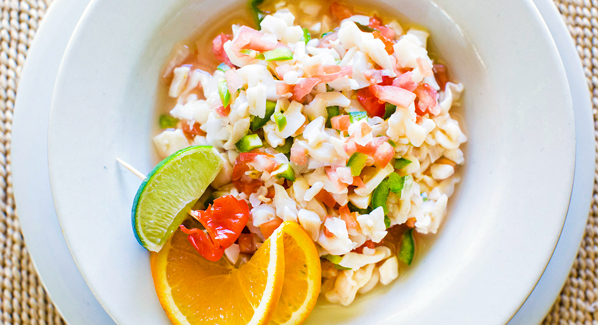
Conch Salad is on most menus at resorts and beach shacks in Eleuthera. Photo: Bahamas Ministry of Tourism
Pelion, Greece
The Greek Islands are among the world’s most sought-after vacation destinations. From the sun-spangled shores and turquoise waters to the savory cuisines, there’s a lot to enjoy — and many who come to enjoy. Santorini receives more than 2 million visitors yearly, and this island is not much bigger than Manhattan. Several guidebooks provide strategies for avoiding the crowds and seeking out the less- visited islands. But another option escapes most international visitors: skip the islands and head for Pelion.
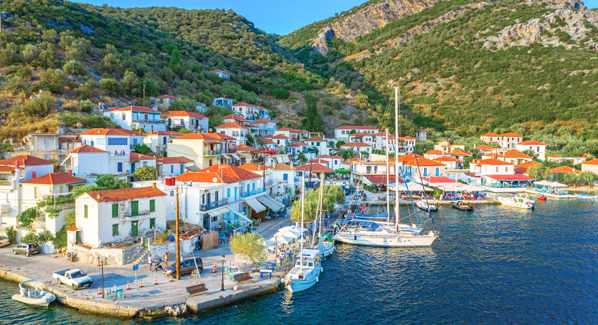
Agia Kiriaki is a traditional fishing village and harbor of Trikeri, Magnesia, Pelion, Greece. Photo: Gatsi/iStock
Mile-high Mount Pelion overlooks a peninsula of the same name that sits on the northeast coast of the Greek mainland. It’s a quick flight or a four-hour drive from Athens and a favorite local vacation destination. What you won’t see are many international visitors. In that respect, Pelion remains one of those oft-cliched “hidden gems.”
The Pelion Peninsula is washed by the same clear Aegean Sea waters found in the southern islands, and the coastline is perforated by coves sheltering golden sand beaches. Ashore, there are inviting waterfront tavernas and charming guest houses in picturesque stone villages. And there is altitude. The foothills of the region’s namesake mountain rise from the shore to forested slopes, where hiking trails lead to mountainside caverns, scenic overlooks, and waterfalls.
The juxtaposition of sea and slopes has blessed the Pelion region with a unique cuisine that foodies in the know widely acclaim. The hearty local fare celebrates simple ingredients sourced from mountain climes. Favorite recipes often combine wild-harvested nuts, berries, mushrooms, and aromatic herbs such as thyme, mountain tea, and oregano. Seafood is always on the menu, and the signature local specialty, spetzofai, is a marriage of hearty country sausage and spicy peppers best paired with a local vintage, as this region is also known for its boutique wineries.
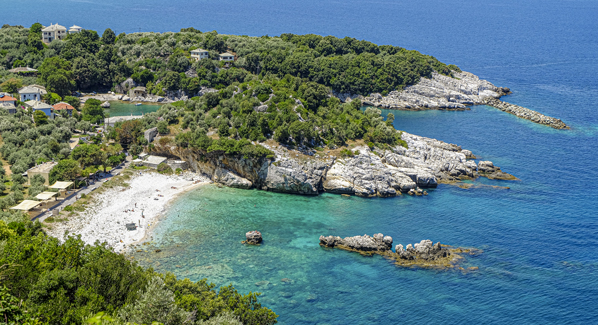
The picturesque village Damouchari on the east coast of the Pelion was chosen as one of the film “Mamma Mia” locations. Photo: Leonsbox/iStock
Riviera Nayarit, Mexico
Puerto Vallarta has been a favorite escape for norte-americanos since the early 1960s, as film history buffs might recall from the classic flick “The Night of the Iguana.” Sitting at the mid-point of the expansive Bay of Banderas, this Pacific coast city’s enduring popularity is fueled by a setting that melds sun and sand into a lively urban setting of cafes, clubs, and boutique hotels. In recent years, a different scene has emerged in the region just north of Puerto Vallarta in the adjoining state of Nayarit. Closest to the city are the resort and golf course complexes of Nuevo Vallarta. Here, the sands are less crowded, the music is softer, and the hotels add a star. Parking lots with late-model luxury sedans bearing Mexico City plates reflect the mix of affluent Mexican nationals and foreign visitors seeking a sophisticated take on beach life.
A bit farther north, the scene changes again as once-sleepy fishing villages such as Bucerias and La Cruz de Huanacaxtle sport new condos occupied by seasonal snowbirds and digital nomads. Fortunately, this influx has yet to tarnish the small-town vibe of the northern bay. Fishermen still ply their day’s catch from panga boats beached on the waterfront, and the village Xocalo (square) is still the center of social life.
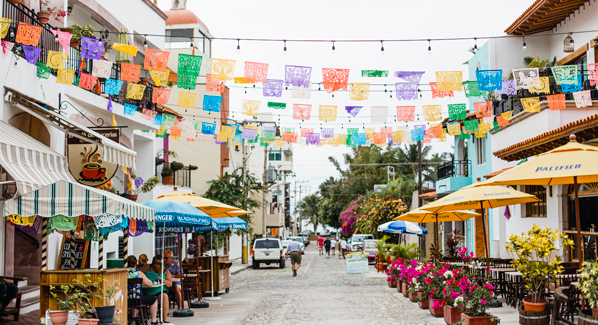
Street scene of the small town of Bucerias, Riviera Nayarit. Photo: Linda Raymond/iStock
Nayarit’s third act begins at the top, where the Punta Mita peninsula has been transformed from a quiet fishing enclave into one of Mexico’s most exclusive resort destinations. This is the destination where limousines whisk VIPs from the Puerto Vallarta Airport to high-dollar suites at the St. Regis and the Four Seasons. An added perk for ocean-view rooms is the chance to see migrating humpback whales swimming offshore.
If the high life is off the menu, Nayarit offers yet another option, another short drive to the north. The poster child for this region is the village of Sayulita, an eclectic mix of a surfer’s mecca, an artist’s enclave, and a new-age wellness and yoga retreat. Adding to the appeal for nature lovers is the town’s proximity to the trails and forests of the Sierra Madre Mountains.
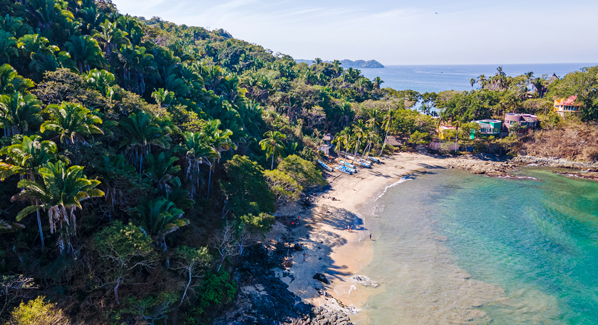
Overview of a hidden small beach surrounded by tropical palm trees in San Pancho, Nayarit, Mexico. Photo: Pyrosky/iStock
Jarabacoa, Dominica Republic
The Dominica Republic is the land of the all-inclusive vacation. Resort complexes spread along the island’s northeastern shores consistently deliver on the promise of hassle-free relaxations where everything from poolside libation to a late-night snack can be had with the wave of a hand.
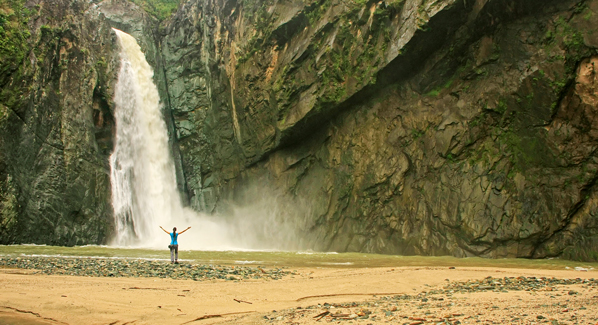
A famous waterfall in the Dominican Republic is Salto Jimenoa Uno. Photo: Donyanedomam/iStock
But there’s more to the DR than open bars, buffets, and beach time. Right in the center of the country is the village of Jarabacoa, which nestles into the foothills of the Cordillera Central Mountains — often referred to by tourism types as “The Dominican Alps.” This elevated geological spine boasts the highest mountains in the Caribbean, with the summit of Pico Duarte Mountain topping a bit above 10,000 feet.
With a climate tempered by altitude, Jarabacoa offers a mild respite from coastal heat. It’s also the starting point for all eco-adventures into the highlands. Active travelers come for climbing, whitewater rafting, trekking, caving, and mountain biking. But the destination is for more than just the lean and fit, as many trails follow gentler slopes through pine forests where clear-water streams lead to refreshing waterfalls. And for a more straightforward ascent to the Caribbean’s highest point, it’s possible to leave the hiking boots behind and climb horseback.
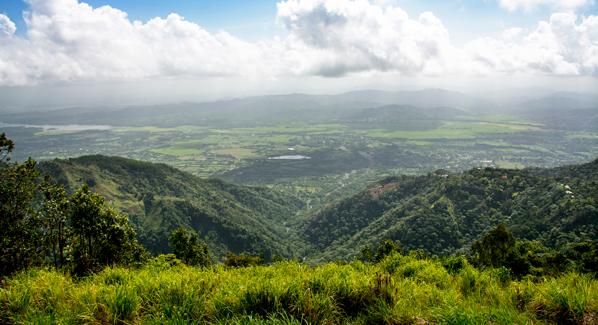
View of the Jarabacoa Valley, Dominican Republic. Photo: jimmyvillalta/iStock
Raiatea, Tahiti
Sparkling lagoons, emerald volcanic peaks, and thatch-roofed over- water bungalows are what French Polynesia is known for. These enduring images define the Tahitian vacation experience and are most often associated with the islands of Bora Bora and Moorea. Only some visitors opt for another Tahiti Society Island group member, which gets scant mention in the brochures. That Island is Raiatea.
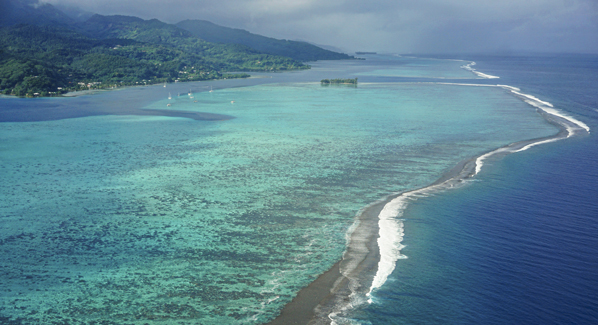
Aerial view of tropical lagoon and coral barrier reef of Raiatea island, French Polynesia. Photo: Damocean/iStock
Raiatea is easily reached by commuter flights from Tahiti’s international airport or a quick hop from Bora Bora. Like other islands in the Society Islands group, it is ringed by a pristine lagoon brimming with coral reefs and tropical fish. The unique combination of heritage and unspoiled natural beauty makes Raiatea an attractive alternative to its more visited neighbors.
Raiatea is considered the birthplace and spiritual hub of Polynesian culture, known by its traditional name as Havai’i, the homeland of the M?ori people. Thought to be the island that launched wide- ranging maritime migrations to Hawaii, New Zealand, and other corners of Oceania, it is a sacred place in traditional culture, where verdant valleys and forests hide ancient temples and ceremonial sites. The 1,000-year-old Taputapuatea Marae temple complex is the best-known, now a UNESCO World Heritage Site.
The lush valleys, hidden coves, and forested slopes of Raiatea invite exploration by foot, and there are miles of hiking trails to discover. Both nature lovers and botanists find Raiatea fascinating, as it is home to several unique endemic plants. The slopes of the island’s landmark, Mount Temehani, shelter the rare Tiare Apetahi, a delicate dawn-blooming flower found nowhere else in the world.
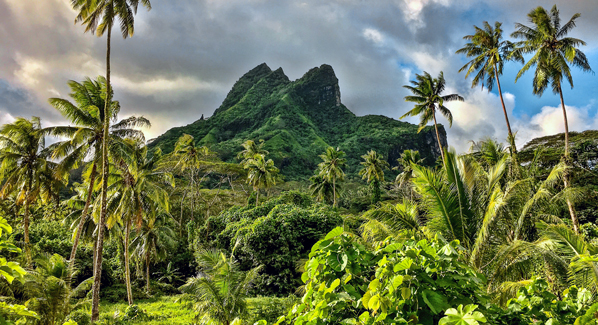
Tall coconut palms and an ancient extinct volcano on Raiatea Island, French Polynesia. Photo: CampPhoto/iStock

